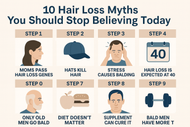10 Hair Loss Myths You Should Stop Believing Today
Posted by xandrox on 30th Sep 2025
Hair loss is surrounded by misinformation, and these myths often stop people from getting the right treatment. If you’ve heard conflicting advice about why hair falls out or how to stop it, you’re not alone. Today, we’re busting the top 10 hair loss myths so you can focus on what really works.
Myth 1: Only Old Men Go Bald
Truth: Hair loss can start as early as your 20s. Both men and women are affected, and age is just one factor among genetics, hormones, and health.
Myth 2: Moms Pass Hair Loss Genes
Truth: While genes from your mother’s side matter, your father’s side also plays a role. Baldness is polygenic, meaning it’s influenced by multiple genes—not just one.
Myth 3: Hats Kill Hair
Truth: Wearing hats doesn’t cause hair loss. Unless your hat is extremely tight and causes friction daily, it won’t affect your hair follicles.
Myth 4: Stress Causes Balding
Truth: Stress may trigger temporary shedding (telogen effluvium), but it doesn’t cause permanent baldness. Genetics and hormones are the main culprits in long-term hair loss.
Myth 5: Hair Loss Is Expected at 40
Truth: There’s no magical age when hair starts falling out. Some people notice thinning in their 20s, while others keep full hair into their 60s. It depends on genetics and health, not just age.
Myth 6: Diet Doesn’t Matter
Truth: Nutrition plays a huge role in hair health. A lack of protein, iron, vitamin D, or omega-3s can accelerate shedding. Eating a balanced diet can slow hair loss and improve thickness.
Myth 7: Supplements Can Cure It
Truth: While vitamins and supplements support hair health, they cannot cure genetic hair loss. Treatments like Minoxidil and Finasteride are still the gold standard for regrowth.
Myth 8: Bald Men Have More Testosterone
Truth: Baldness is linked to sensitivity to DHT (a byproduct of testosterone), not higher testosterone levels. Many bald men actually have average or even lower testosterone compared to men with full hair.
Myth 9: Only Expensive Treatments Work
Truth: FDA-approved options like Minoxidil and Finasteride are affordable and effective. You don’t need luxury shampoos or miracle serums to see real results.
Myth 10: Nothing Can Be Done
Truth: Hair loss can be treated and managed. With the right approach—whether it’s topical solutions, oral medication, nutrition, or a combination—you can slow shedding and even regrow hair.
Final Thoughts
Hair loss myths create confusion and discourage people from seeking real solutions. The truth is, proven treatments exist, and with consistency, many people see noticeable results.
? Want expert guidance on your hair loss journey? Contact our team today to explore the best treatment options for you.

